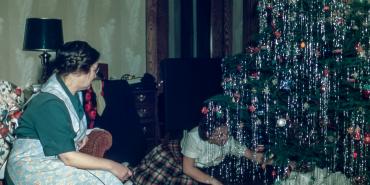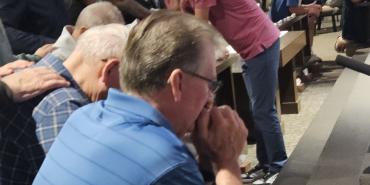Holiness Through Generations

Ann Cubie Rearick and Mary Rearick Paul, mother and daughter, were both raised in ministry homes and are both still in ministry. Here, these women express their perspectives regarding the experience of growing up in a holiness environment.
Ann Cubie Rearick:
"Follow peace with all men, and holiness, without which no man shall see the Lord (Hebrews 12:14, KJV)."
When I was a child in the '40s this verse, along with the interpretive label of "Holiness or Hell," was the subject of at least one sermon in each set of revival meetings and at holiness camp meetings. We believe in two definite works of grace and all members of our church were expected to give testimony of where and when they received both. During Wednesday night prayer meetings, people would often testify to being saved on a certain date and being sanctified on another date.
One positive aspect of this was that we knew who we were. We were Nazarenes and believed in holiness. We often classified ourselves as being part of the Holiness Movement, rather than being counted among "evangelicals." I remember hearing sermons from my father and others on scriptural holiness and the need for sanctification. Romans and Thessalonians were favorite scriptures for holiness sermons. We knew that after coming to Christ for forgiveness of sins, we needed to give ourselves totally to God and ask the Holy Spirit to fill us. I was taught the five points of Calvinism and why we didn't believe their validity. I also knew the claims of the Pentecostals and why we didn't believe those.
We Nazarenes were loyal to our doctrine and to our church. Because of this, most of our young people attended a Nazarene college, preferably on our own zone. From the time I was five years old, I knew I would someday attend Eastern Nazarene College. As part of the holiness emphasis, we learned we were to live without sin. When I was a teenager, I had some Baptist friends who believed they sinned every day in thought, word, and deed. I quoted to them from 1 John 3:8 (KJV), "He that committeth sin is of the devil," and felt I had really scored a point for "our side." Of course, part of our differences lay in our definitions of sin. Their definition of sin was "anything short of the glory of God," and ours was "a willful transgression of the known will of God." Perhaps their definition was too broad and ours too narrow.
For example, their definition considered it sin if we were simply annoyed with someone. We sometimes brushed off an unloving attitude as something we weren't responsible for—we didn't recognize that when we do nothing about a bad attitude it becomes sin. Thus some testified to having not sinned for 40 years, a claim that I believe does not hold true in human experience. Both take away the seriousness of sin. Another problem arose for many of us because in our eyes, the "known will of God" included not only the scripture but also every written and unwritten rule of the church—including wearing a ring or wearing lipstick. We were to obey church cultural mores as much as scriptural admonitions. We who were teenagers at the time felt if we transgressed in any way we were no longer Christians and would have to go through the two works of grace again. This led to great instability for many—and resulted in lined altars at revival and camp meetings. Holiness preaching in my youth emphasized the "crisis." According to many testimonies, salvation and sanctification were unmistakable emotional experiences, that often were supposed to solve all problems of life.
Many of us believed this so much that if we did not experience strong emotions, or if we struggled with anything afterward, we doubted our experiences or felt the doctrine was flawed, rather than faulting our understandings of the doctrine.
Our challenge today is to not ignore the importance of our distinctive doctrine and at the same time to not ignore the necessity of teaching the progressive nature of our holiness journey.
The words of 1 John 2:1, "My little children, I write these things unto you, so that you may not sin" also include, "But if anyone does sin, we have an advocate with the Father, Jesus Christ the righteous (NRSV)." When one is "overtaken in a fault" or sins, the answer is sorrow for the sin, confession to God, receiving His forgiveness, and continuing on the journey.
Mary Rearick Paul
When I was a child in the '60s and '70s, the themes proclaimed from the pulpit were facing transition. While I do not recall "Holiness or Hell" messages, the two definite works of grace were emphasized in sermons, testimonies, and altar calls. Most Nazarene churches I visited had a banner declaring our distinctive doctrine, "Holiness Unto the Lord." While we still discussed "once saved and always saved" versus "backsliding," few of the younger generation were interested in these debates. Because of the growing ecumenical movement we talked more about what we had in common than our differences.
I remember my excitement and confusion when the charismatic movement hit our local Catholic church. Classmates began to talk about personal experiences of faith in Christ, yet they still practiced behaviors that weren't "Christian." My whole understanding of who was "in" and who was "out" was stretched. By the late '70s I began to hear the church present a growing emphasis on holiness in the context of dynamic relationship. I learned the language of journey, discipleship, and maturing growth that offered an alternative to the instability of an "in grace" or "out of grace" mentality. Church members faced an honest struggle regarding the crisis experience of sanctification, when at a later point, they would have to confess sin again and ask for forgiveness. At camp meetings, mornings featured youth meetings with contemporary music and discipleship teachings, while evening meetings focused on adults, hymns, and calls to make crisis decisions in our Christian experience. It seems as if the Church of the Nazarene has been trying to reconcile those two messages throughout my adult life.
As a church we need to be creative in our modes of communication so we can effectively proclaim the good news of a holiness theology.
The challenge of every generation is to rearticulate truths in a way that connects with people. We also have to continue to define the core commitments of our denomination and let go of cultural expressions that have served their purpose and time. We have much to offer our brothers and sisters in Christ and the larger world community as we proclaim our holiness message. This should not be washed away in the generic evangelical swirl.
Ann Cubie Rearick is chaplain at Quincy, Massachusetts, Medical Center after pastoring the Massapequa Park, New York, Church of the Nazarene with her husband, Andy.
Mary Rearick Paul is pastor at St. Paul Church of the Nazarene in Duxbury, Massachusetts, with her husband, Bruce.
Holiness Today, January/February 2005
Please note: This article was originally published in 2005. All facts, figures, and titles were accurate to the best of our knowledge at that time but may have since changed.




